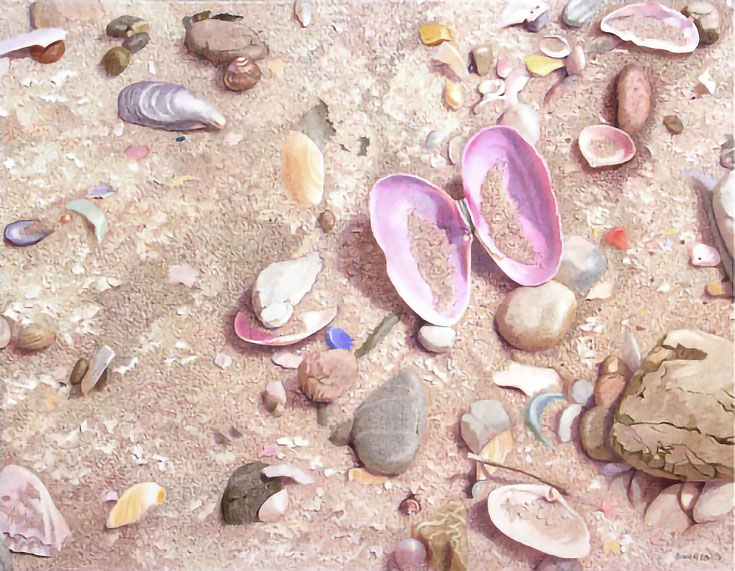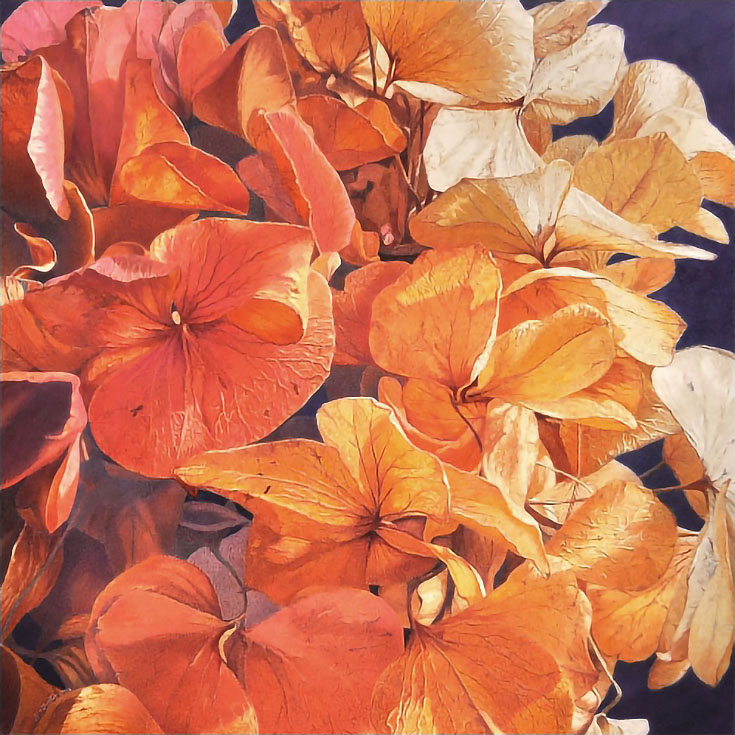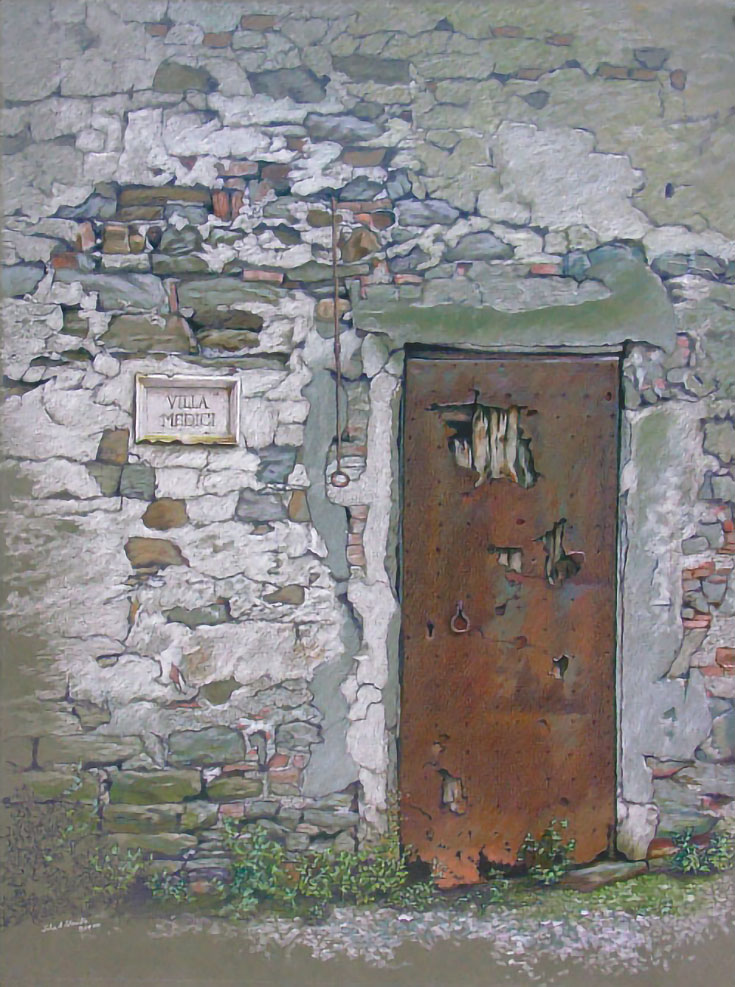“John Ursillo’s colored pencil pieces are absolutely brilliant. Every colored pencil piece I’ve observed is strengthened by John’s ability to capture light and texture. [He] explores what many describe as a difficult medium with apparent ease: A true master.” Brian Sherwin, Art Critic
I can add nothing to Brian Sherwin’s comments about John Ursillo’s colored pencil artwork. Whether his subjects are architectural, floral, landscape, or human, he is able to infuse his drawings with light and mystery.
Following is our “conversation by email” about his work, why he chose colored pencil, and a little bit about his process.
Carrie Lewis: Thank you for talking with us. How did you get started with colored pencil?
John Ursillo: Colored pencils have been a part of my choice of media since I was a child, along with the usual crayons, fingerpaint and kiddie watercolor sets. My Mom did paint by number oils, some quite large, and I was encouraged to work on my own alongside her. So my involvement with our favorite medium started early out of necessity. Colored pencil was then, as now, portable, clean and easy to carry about, set up and clean up.
My art education started as a direct result of my failure with colored pencils. I recall struggling with the face on a drawing I was attempting to copy in colored pencil. I erased so much that I wore a hole where the face should have been but patched it up with glue and a swatch of paper to keep at it.
My Mom, who was my first “best critic,” decided that if I were that determined I should get some instruction. She made arrangements with a friend of the family who was a prominent pastel artist to give me weekly private sessions.
I was joined by a girl student in this and we two embarked on a 3 year course starting with graphite, charcoal and newsprint. We drew from still life setups and didn’t touch color in the classroom for the first year. We then graduated to watercolor, pastel and finally oils—but never colored pencil. Mrs. Grande, our teacher, apparently didn’t consider colored pencil to be much of a professional medium.
Beach Treasures
CL: What most often inspires your colored pencil work?
JU: The love of light is my inspiration and informs all the subjects I choose. As a colorist at heart, I make paintings that have been critically noted for their ability to render light; giving them an almost palpable sense of time, realism, depth, and volume. I consider myself a “story teller” artist. I work to intentionally build into my pieces via subject, composition, color, and light a bit of mystery, unexpectedness or emotion as a way of conveying to the viewer my experience of the time or place captured on the canvas or paper. Isn’t that, after all is said, what it’s all about?
CL: What do you look for when you’re looking for something to draw?
JU: The range of subject matter in my work is rather broad: still life, landscapes, the American Civil War, seascapes, ships, mountains, deserts, people—almost every genre one can put on a surface. Maybe one day I’ll get so passionate about some one subject that I will paint nothing else. But I hope not. . . there’s just too much out there given to us to work with.
Hydrangea Landscape #2—Last Blush
CL: So how do you go about choosing a subject?
JU: I have nearly always kept a library of reference photographs, mostly my own and some from published sources. As I acquired some professionalism I put the published material away for my students to use.
I still keep a huge collection of my own reference pictures. Digital photography has made that so much easier and cheaper. I gradually scan my older pictures from the photo albums as I access them for project ideas or reference. I keep all in digital form organized by subject matter. I use a visual database called “Media Pro” to organize and tag.
I take photographs constantly, always looking for interesting subjects, lighting effects, colors etc. as you mentioned. This is the grist for my idea mill. I use the database for ideas by tagging pictures I take with a rating: 1 star = maybe, 2 stars = maybe more, up to 4 stars = probable, and 5 stars=work in progress (either planning or under way).
I do this for each new batch of pictures—I obviously don’t tag EVERY shot with a rating but do so for only those I feel might make a good drawing someday.
As an aside, when I photograph I generally capture three kinds of image: one for general reference (skies, trees, etc), the second for composition (I try to compose in the camera any subject I think might work for a picture), third I will take shots of the second, compositional subject with bracketed exposures to lighten the shadows and suppress the highlights—thus gathering information about what’s in those shadows and highlights that the human eye can see but the casual camera shot misses.
Ever wonder why some artists make pictures where the shadows are so very dark or the lights so blown out? Probably they are working from references in which important areas have not been exposed properly to give them the information they need. This is critical. It’s also a very good reason to cultivate doing some plein air drawing so one becomes familiar with how nature differs from photographs.
Whenever I get in the mood, either from boredom or a need to look into the crystal ball for my next large colored pencil piece I turn to my database and the ranked images as a starting point.
Door at Villa Medici, Fiesole, Italy
CL: What artists influence your work most?
JU: I have always been a “realist.” Thus my works rely on strong composition and design, contrasts, and subtle atmospheric perspective techniques learned from my mentors, among whom I count my earliest mentor, Laura Grande, my admired artist friends, and workshop masters such as Joseph Mendez and Frank LaLumia. But I have always been strongly influenced in subject matter, color appreciation and “story” by illustrator/artists such as Pyle, Rockwell and Wyeth (both N.C. and Andrew although lately I’ve been developing a better appreciation of Jamie’s work).
That said, I’m a student of the history of art and take inspiration from a number of additional, diverse sources. My spring of influence flows out from the Italian Renaissance but only marginally into the modern. I think Vincent is about my current limit in that direction, while the American Impressionists and moderns, particularly Robert Henri, give me much to think about especially through their writings as well as paintings.
John Ursillo’s work is available on line in both original and print form. If you haven’t visited his website before, I urge you to take time to do so now. If nothing else, his choice of subjects and the nature of his works may be just the bit of inspiration you’re looking for.
This post may contain affiliate links.



